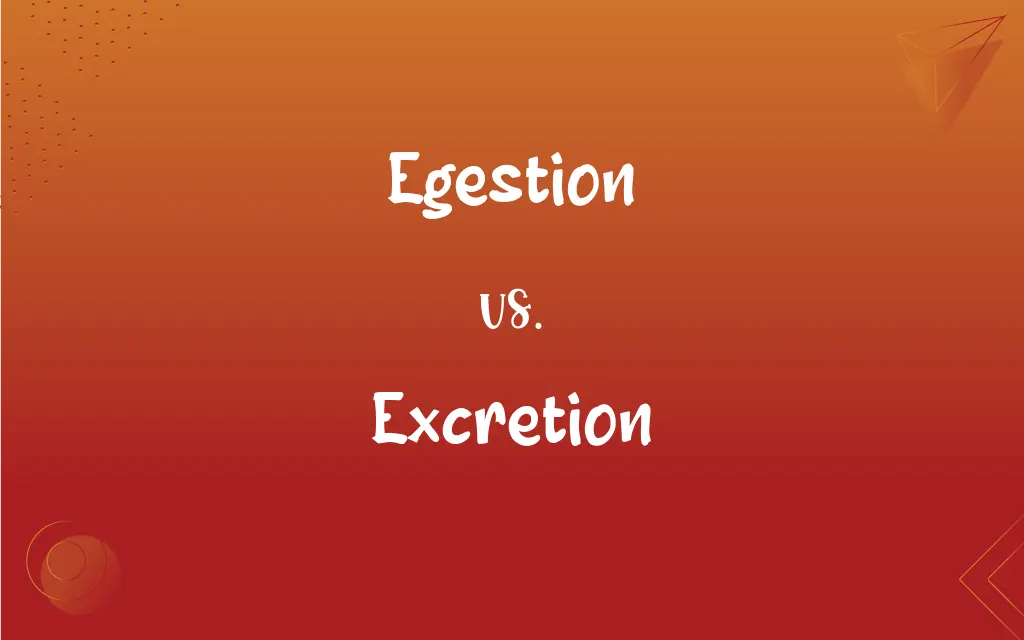Egestion vs. Excretion: What's the Difference?
Edited by Janet White || By Harlon Moss || Updated on October 16, 2023
Egestion refers to the expulsion of undigested food, while excretion is the process of removing metabolic wastes from the body.

Key Differences
Egestion and excretion are both mechanisms through which organisms eliminate waste. Egestion involves the removal of indigestible food remnants, while excretion pertains to the removal of metabolic wastes produced during the body's physiological processes.
Egestion usually occurs through the digestive system's end, specifically the anus in many animals. Excretion, however, takes place through various organs like kidneys, lungs, and skin, depending on the type of waste being expelled.
An easy way to differentiate between egestion and excretion is to consider their origins. Egestion deals with substances that have entered the digestive system but were not absorbed due to their indigestibility. Excretion deals with wastes produced internally from metabolic activities.
Both egestion and excretion are crucial for maintaining an organism's internal balance. Egestion prevents the accumulation of indigestible food, while excretion ensures that potentially harmful metabolic wastes don't build up.
While egestion is primarily a concern for organisms with complex digestive systems, excretion is universal. All organisms, from single-celled to multicellular, have mechanisms for excreting metabolic wastes.
ADVERTISEMENT
Comparison Chart
Definition
Expulsion of undigested food.
Process of removing metabolic wastes.
Origin
From the digestive system.
From metabolic activities within the body.
Primary Organs
Anus, in many animals.
Kidneys, lungs, skin, among others.
Nature of Waste
Indigestible remnants.
By-products of metabolic processes.
Universality
Primarily in complex organisms.
Universal across all organisms.
ADVERTISEMENT
Egestion and Excretion Definitions
Egestion
Egestion refers to the expulsion of food remnants not absorbed during digestion.
After a meal, the worm egests soil particles that it cannot digest.
Excretion
Excretion is the process by which organisms eliminate metabolic wastes.
The kidneys play a pivotal role in the excretion of urea from the bloodstream.
Egestion
Egestion is the elimination of undigested food from the body.
Birds egest small, solid pellets containing bones and feathers of their prey.
Excretion
Excretion involves the removal of by-products from the body's physiological reactions.
Through excretion, the human skin releases sweat containing salts and urea.
Egestion
Egestion is the removal of waste products resulting from the digestive process.
The human body egests fibrous materials through feces.
Excretion
Excretion ensures harmful substances generated internally don't accumulate.
Plants perform excretion by depositing waste in leaves that eventually fall off.
Egestion
Egestion is the act of discharging material that can't be broken down further in the digestive tract.
Rabbits egest pellets, which they sometimes reingest for further nutrient extraction.
Excretion
Excretion is the act of discarding substances not needed by the body.
Fish excrete ammonia directly into the water through their gills.
Egestion
Egestion is the final step in the digestion process, ensuring unwanted materials exit the organism.
Insects egest waste in the form of small, solid frass.
Excretion
Excretion maintains the body's internal balance by getting rid of excess or toxic substances.
The lungs excrete carbon dioxide, a by-product of cellular respiration.
Egestion
To discharge or excrete from the body.
Excretion
The act or process of discharging waste matter from the blood, tissues, or organs.
Egestion
The act or result of egesting
Egestion
Act or process of egesting; a voiding.
FAQs
What is egestion?
Egestion is the expulsion of undigested food from the body.
Which organ is primarily involved in egestion in humans?
The anus is the primary organ for egestion in humans.
Can egestion occur in single-celled organisms?
Single-celled organisms can egest wastes, typically by expelling them from the cell membrane.
Is feces a product of egestion or excretion?
Feces is a product of egestion, consisting of undigested food remnants.
Are sweat and urine products of egestion or excretion?
Both sweat and urine are products of excretion.
How do plants perform excretion?
Plants perform excretion by depositing wastes in leaves, bark, or the soil.
What would happen without egestion?
Without egestion, undigested food would accumulate in the body, leading to blockages and health issues.
Is the removal of drugs from the body egestion or excretion?
The removal of drugs is typically a form of excretion.
Do plants perform egestion?
Plants don't perform egestion in the same way animals do, but they can get rid of waste materials through fallen leaves or secretions.
What is the primary purpose of excretion?
The primary purpose of excretion is to remove metabolic wastes from the body.
Can excretion be linked to homeostasis?
Yes, excretion helps maintain homeostasis by regulating waste and toxin levels in the body.
Is breathing a form of excretion?
Yes, breathing can be considered a form of excretion as carbon dioxide is expelled.
Can a problem in egestion affect excretion?
While both processes are distinct, severe issues in egestion might indirectly impact excretion, especially if toxins or blockages interfere with overall body function.
How does egestion differ from excretion?
Egestion deals with undigested food, while excretion removes metabolic wastes.
Are hair and nails considered egestion products?
No, hair and nails are not egestion products; they are growth products.
Is mucus a product of egestion or excretion?
Mucus is neither a product of egestion nor excretion; it is a secretion for protection and lubrication.
Do all animals excrete the same way?
No, different animals have various excretory mechanisms, such as urine, sweat, or ammonia.
Is egestion a form of waste management?
Yes, egestion is a natural waste management process for undigested food.
Which is more universal, egestion or excretion?
Excretion is more universal, occurring in all organisms, whereas egestion is more specific to organisms with digestive systems.
Are kidneys related to egestion?
No, kidneys are primarily involved in excretion, filtering out metabolic wastes from the blood.
About Author
Written by
Harlon MossHarlon is a seasoned quality moderator and accomplished content writer for Difference Wiki. An alumnus of the prestigious University of California, he earned his degree in Computer Science. Leveraging his academic background, Harlon brings a meticulous and informed perspective to his work, ensuring content accuracy and excellence.
Edited by
Janet WhiteJanet White has been an esteemed writer and blogger for Difference Wiki. Holding a Master's degree in Science and Medical Journalism from the prestigious Boston University, she has consistently demonstrated her expertise and passion for her field. When she's not immersed in her work, Janet relishes her time exercising, delving into a good book, and cherishing moments with friends and family.































































